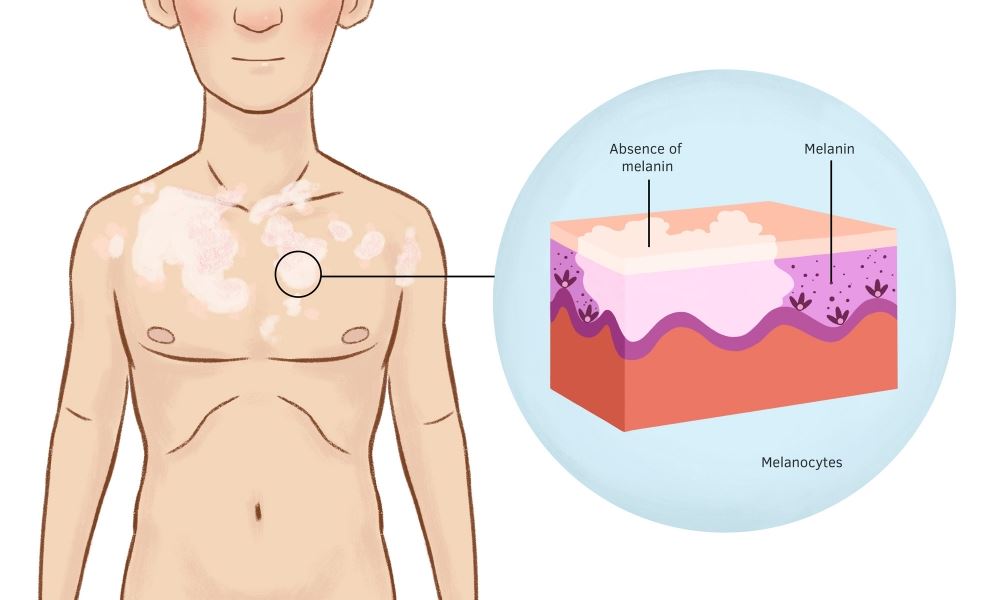
Vitiligo is a skin disorder that causes patches of white skin on the body. It affects approximately 0.5 percent of the population worldwide. People with this condition have white patches all over their bodies, often covering entire areas of the body. A famous celebrity with vitiligo is Winnie Harlow. The condition can be embarrassing and even painful. Patients report that people are afraid to touch them. If you suspect you might have vitiligo, see a doctor as soon as possible.
Vitiligo is a chronic condition, but symptoms can be controlled. Some remedies may be available to reduce the visibility of the affected area. Avoiding excessive sun exposure is important for the light patches of skin. Wear sunscreen whenever possible. Using UVB lamps is another treatment. These lamps are worn daily. If you don’t have a home UVB lamp, you can purchase one that you can use on a daily basis. If you’d rather spend the money, opt for the latter. It’s an effective option for people with vitiligo, but it’s time-consuming and can result in other side effects.
The first signs of vitiligo include the appearance of white patches on the face and hands. It may be accompanied by other physical signs, such as a rash, so you should consult a doctor to discuss the symptoms of vitiligo. The doctor can also perform a physical exam and run lab tests. It’s important to disclose any medical conditions that you have, including any autoimmune disease you have or family history.
While there’s no cure for vitiligo, you can try a number of treatments to slow down the discoloration. You can take medication to help your skin retain its natural pigment. Your doctor may prescribe some medications to help. You can also go for therapy if you feel depressed about your vitiligo. But make sure you discuss the issue with your physician, especially if you have symptoms of depression.
While vitiligo is not painful, it can be unsightly. If it affects your face, you will notice white patches on your face. It affects all races equally, although dark-skinned people tend to have worse patches than other people. To prevent further damage to your skin, you should avoid exposure to the sun. You should wear protective clothing and use a daily UVA/UVB sunscreen.

Treatments for vitiligo will vary depending on the type of vitiligo. There are two types of vitiligo: non-segmental and segmental. The former affects a small part of the body, while the latter affects several parts of the body. Both types of vitiligo will present the same symptoms on your face and neck, and can be treated with different methods.
If you’ve had vitiligo for a long time, you’ve probably experienced discoloration and loss of skin pigmentation. It is important to see a doctor as these symptoms can be life-threatening. A dermatologist can help you determine the best course of treatment for your particular condition. Your doctor may also prescribe a prescription drug to treat this condition. You can also try herbal supplements and vitamin A for vitiligo.
Fortunately, vitiligo does not cause pain, but it can be uncomfortable. It is usually noticeable in people with darker skin and can be embarrassing for people with fair skin. It can also affect the eyes and mucous membranes of the mouth. However, this does not happen to everyone. Although most patients do not notice symptoms, if you have vitiligo, you may be more likely to develop the disease.
Some people have a family history of this disorder, but there are no genetics that make people more susceptible to this disorder. While genes may play a role in the disease, the condition itself has no known cause. In most patients with vitiligo, the skin on various parts of the body loses color, and their skin may appear completely white. Despite the symptoms, they are still difficult to manage. If you have vitiligo, it is important to see a dermatologist and visit the site as soon as possible Handal Dok.
Vitiligo symptoms include discoloration of the skin on the lips and legs. In some people, spots may appear on the entire body or only on part of it. Fortunately, most people with vitiligo do not experience any complications. But if the disease affects your child, you should immediately consult a doctor. If the symptoms are severe, you should check with your pediatrician to see if they need any additional treatment.

Leave a Reply